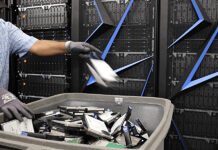Supermicro says Fibre Channel is on the way out, but SAS lives on and...
Interview: We had the opportunity to discuss storage servers with Supermicro and find out how it designs and customizes them for its customers, and how interfaces are changing. Wendell...
VDURA adds V5000 all-flash node for faster mass data access
HPC and AI parallel file system storage supplier VDURA has added a high-capacity all-flash storage node to its V5000 hardware architecture platform.
The V5000 was introduced just over three months...
Chinese scientists spin molecular hard disk drive idea
Chinese scientists have devised an organic so-called molecular hard drive for archiving with multi-bit encrypted storage molecules written and read using an atomic force microscope.
The notion is presented in...
Western Digital, Sandisk begin separate trading after split
Western Digital and Sandisk started trading their stocks as separate businesses on February 24, with Western Digital shares losing 2.9 percent and Sandisk's 7 percent of their value, which,...
Used Seagate drives sold as new through online retail channels
Used Seagate EXOS drives presented as new are being sold through online retail channels, duping both buyers and sellers. The storage biz has now launched an investigation to find...
DDN on files, objects and AI training and inference
Interview DDN has been supplying high speed file access with its EXAScaler Lustre parallel file system software for many years. This supports Nvidia’s GPUDirect protocol. It has just announced...
StorONE advances auto-tiering with AI-driven TierONE
StorONE is offering updated storage tiering with AI-powered TierONE software and improved data protection with SnapONE.
The company claims customers don’t need all-flash array (AFA) systems to get fast performance,...
Lenovo reports third straight quarter of double-digit growth
Lenovo reported its third consecutive quarter of double-digit revenue growth, with all three business units contributing at double-digit levels.
Revenues in the quarter ending December 31, 2024 were $18.8 billion...
How constant frustration drives storage developments
Comment Storage is always in flux, from underlying media to new ways to access on-drive storage and specialized large language model databases. Workloads need more data. They need it...
It’s HAMR time for WD as it outlines drive migration plans
Western Digital revealed its HAMR disk technology migration plans in an Investor Day session and already has HAMR drives undergoing qualification by customers.
The Investor Day session was held to...
Sputtering Seagate, storage giant wants to buy Intevac
Seagate plans on spending $119 million to buy Intevac, a maker of sputtering tools used to coat disk drive platters with thin films.
Intevac’s 200 Lean machine applies thin films,...
A VAST effort: Data estate vectorization and storage for the AI era
All data storage companies are having to respond to the wave of generative AI and intelligent agents interrogating an organization’s data estate, be it block, file, or object, and...













